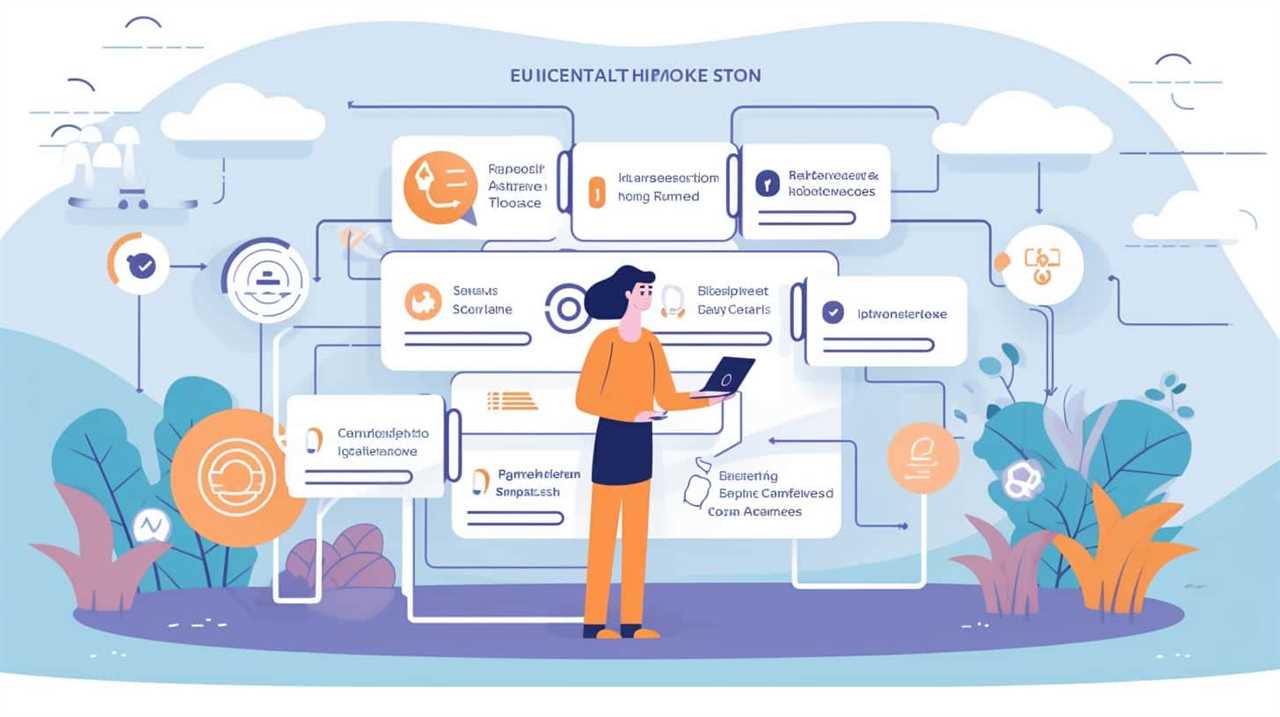Looking to improve your SEO rankings and attract more organic traffic to your site? Look no further than the secret weapon of your SEO strategies: content quality.
In today’s competitive online landscape, simply churning out a high quantity of content is no longer enough. To truly stand out and engage your audience, you need to prioritize content quality.
Join us as we explore the impact of content quality on SEO rankings, user engagement, and conversion rate optimization.
Get ready to master the art of creating high-quality content that gets results.

Key Takeaways
- Content quality is crucial for SEO strategy, as it improves search engine rankings and fosters connections with the audience.
- Prioritizing content relevance and credibility is essential in order to address the needs of the target audience and build trust and authority.
- Quality should always be prioritized over quantity in SEO strategy, as high-quality content provides value and meets audience needs, while low-value content can harm SEO efforts.
- User engagement metrics, such as bounce rate, time on page, social media shares, comments, and feedback, reflect the impact of content quality on SEO rankings, while backlink quality acts as a vote of confidence for content and boosts rankings.
The Importance of Content Quality
The importance of content quality can’t be overstated in our SEO strategy. In order to achieve optimal results and stand out in the digital landscape, it’s crucial to prioritize content relevance and credibility.
When it comes to content relevance, we must ensure that our content aligns with the needs and interests of our target audience. By providing valuable and insightful information that directly addresses their pain points, we can establish ourselves as a trusted source of knowledge.
Additionally, content credibility plays a vital role in building trust and authority. By delivering accurate and well-researched content, we can enhance our reputation and attract a loyal following.
High-quality content that’s both relevant and credible not only improves our search engine rankings, but also fosters strong connections with our audience, leading to long-term success in our SEO strategy.

Content Quality Vs. Quantity
In our SEO strategy, we prioritize content quality over quantity. While it may seem tempting to produce a large volume of content in order to increase visibility, we believe that focusing on content relevance and effectiveness is more beneficial in the long run.
Creating high-quality content ensures that it’s valuable to your audience and meets their needs. By providing useful and informative content, you establish yourself as an authority in your industry and build trust with your audience. This can lead to higher engagement, increased brand awareness, and ultimately, better search engine rankings.
On the other hand, prioritizing quantity over quality can result in low-value content that doesn’t resonate with your target audience. Such content may not be effective in attracting and retaining readers, and can even harm your SEO efforts.
How Content Quality Impacts SEO Rankings
When it comes to SEO rankings, content quality plays a crucial role. Search engine ranking algorithms are constantly being updated to prioritize high-quality content that provides value to users.

Engaging and informative content that keeps users on your page for longer and encourages them to share and interact with it positively impacts your SEO rankings.
Additionally, the quality of backlinks pointing to your content also plays a significant role in determining your website’s authority and visibility in search results.
Ranking Algorithm Updates
How does content quality impact SEO rankings?
Ranking algorithm updates play a crucial role in determining the position of a website in search engine results. Search engines like Google are constantly improving their algorithms to provide users with the most relevant and high-quality content. These updates consider various factors, including content quality benchmarks, to determine the ranking of a webpage.

Websites that consistently produce high-quality, informative, and engaging content are more likely to rank higher in search results. On the other hand, websites with low-quality or irrelevant content may see a drop in their rankings.
It’s essential for website owners and content creators to stay updated on ranking algorithm improvements and ensure their content meets the ever-evolving standards of content quality.
User Engagement Metrics
We can observe the impact of content quality on SEO rankings through user engagement metrics. User engagement metrics are measurements that assess how users interact with a website and its content. These metrics provide valuable insights into the effectiveness of a website’s content and its ability to engage users.
When it comes to SEO rankings, user engagement metrics play a crucial role. Here are four ways in which content quality impacts SEO rankings through user engagement metrics:

- Bounce Rate: A high bounce rate indicates that users aren’t finding the content relevant or engaging. This can negatively impact SEO rankings.
- Time on Page: The longer users spend on a page, the more likely it’s that the content is engaging and valuable. This can positively impact SEO rankings.
- Social Media Shares: When users find content valuable, they’re more likely to share it on social media. This can increase visibility and improve SEO rankings.
- Comments and Feedback: User comments and feedback indicate active engagement with the content. This can signal to search engines that the content is relevant and valuable, leading to higher SEO rankings.
Backlink Quality Importance
As we delve into the importance of backlink quality in relation to content quality and its impact on SEO rankings, it’s essential to understand the role backlinks play in driving organic traffic to a website.
Backlinks are links from external websites that point back to your site. These links act as votes of confidence, signaling to search engines that your content is valuable and authoritative. However, not all backlinks are created equal.
Backlink relevance is crucial in determining their quality. Receiving backlinks from high-quality and relevant websites can significantly boost your SEO rankings. To achieve this, it’s important to implement effective link building strategies, such as guest blogging, creating shareable content, and building relationships with influencers in your industry.
User Engagement and Content Quality
When it comes to content quality, user engagement is a crucial factor to consider.

By encouraging interaction with our content, we not only boost our SEO rankings but also enhance the overall user experience.
When users spend more time on our site, share our content, or leave comments, it signals to search engines that our content is valuable.
This can result in higher rankings and increased organic traffic.
Importance of Interaction
User engagement plays a crucial role in determining the impact of content quality on SEO strategy. When it comes to optimizing your website for search engines, it’s not just about creating high-quality content; it’s also about getting users to engage with that content.

Here are four reasons why increasing user engagement is essential for your SEO efforts:
- Improved rankings: Search engines like Google prioritize websites that have high user engagement, as it indicates that the content is valuable and relevant to users.
- Increased organic traffic: When users engage with your content, they’re more likely to share it, link to it, and recommend it to others, which can lead to an increase in organic traffic to your website.
- Reduced bounce rates: Engaging content keeps users on your website for longer, reducing bounce rates and signaling to search engines that your site is trustworthy and provides valuable information.
- Enhanced conversion rates: Engaged users are more likely to take action, such as making a purchase or filling out a contact form, leading to higher conversion rates and improved business outcomes.
By understanding the importance of user interaction and actively working to increase user engagement, you can boost your SEO rankings and drive more organic traffic to your website.
Now, let’s explore some strategies to achieve this.
Boosting SEO Rankings
To continue our exploration of the importance of user engagement in SEO strategy, let’s delve into how boosting SEO rankings is directly influenced by both user engagement and content quality. When it comes to increasing organic traffic and improving search engine rankings, user engagement plays a crucial role. By providing high-quality content that engages users, you can encourage them to spend more time on your website, reducing bounce rates and increasing page views. Additionally, content optimization strategies such as keyword research, incorporating relevant headers and subheadings, and ensuring readability can further enhance your SEO efforts. To illustrate the impact of user engagement and content quality on SEO rankings, take a look at the table below:

| User Engagement Metrics | Content Quality Metrics |
|---|---|
| Bounce Rate | Readability |
| Time on Page | Relevance |
| Page Views | Originality |
| Social Shares | Depth of Information |
Enhancing User Experience
Enhancing user experience involves prioritizing user engagement and content quality. When it comes to improving usability and optimizing readability, there are several key factors to consider:
- Clear and concise content: Users appreciate content that’s easy to understand and navigate. Keep paragraphs short and use headings and subheadings to break up the text.
- Engaging visuals: Incorporate relevant images, videos, and infographics to enhance the user experience. Visuals can help convey information more effectively and keep users engaged.
- Interactive elements: Add interactive features such as quizzes, surveys, or polls to encourage user participation and increase engagement. This can also provide valuable insights into user preferences and interests.
- Responsive design: Ensure your website is mobile-friendly and accessible across different devices. A responsive design allows users to easily navigate and interact with your content, regardless of the device they’re using.
Creating High-Quality Content: Best Practices
When crafting high-quality content, we prioritize engaging storytelling and relevant information. Content curation involves selecting and organizing the best content from various sources to provide value to our audience. By curating content, we can save time and effort while delivering high-quality information. To ensure content relevance, we focus on targeting the right audience. By understanding their needs, interests, and preferences, we can create content that resonates with them. This involves conducting thorough research, analyzing data, and staying updated on industry trends. Additionally, we emphasize the importance of using keywords strategically to optimize our content for search engines. By incorporating relevant keywords in our headlines, subheadings, and body text, we can improve our visibility and attract the right audience.
| Best Practices for Content Curation | |
|---|---|
| 1. Identify reputable sources | Choose reliable and authoritative sources for your content curation. |
| 2. Provide context and commentary | Add value by offering your insights and analysis on the curated content. |
| 3. Regularly update your curated content | Keep your curated content fresh and relevant by regularly reviewing and updating it. |
Optimizing Content for SEO: Quality Signals to Consider
As SEO strategists, we prioritize considering quality signals when optimizing content for search engine optimization. Optimizing keywords is crucial for improving the visibility and ranking of your content. Here are four quality content strategies to consider:
- Keyword Research: Conduct thorough research to identify relevant and high-performing keywords that align with your content. Use tools like Google Keyword Planner or SEMrush to discover popular and less competitive keywords.
- On-Page Optimization: Optimize your content by strategically placing keywords in the title, headings, meta descriptions, and throughout the body. However, ensure that the keywords flow naturally and don’t compromise the readability and user experience.
- High-Quality Content: Create valuable and informative content that addresses the needs and queries of your target audience. Focus on delivering unique insights, well-researched information, and engaging storytelling.
- User Experience: Enhance the user experience by ensuring your content is easy to navigate, visually appealing, and mobile-friendly. Pay attention to factors like page loading speed, responsive design, and clear call-to-actions.
The Role of Content Quality in E-A-T (Expertise, Authoritativeness, Trustworthiness)
When it comes to optimizing your website for search engines, content quality plays a crucial role in boosting your E-A-T.

Trustworthy content is essential for establishing expertise, as it demonstrates your knowledge and authority on a particular topic.
By ensuring that your content is well-written, accurate, and reliable, you strengthen your overall authority and build trust with your audience.
Trustworthy Content Boosts E-A-T
Trustworthy content plays a crucial role in boosting E-A-T (Expertise, Authoritativeness, Trustworthiness) for your SEO strategy. When it comes to building credibility, establishing trust through content quality is essential. By providing accurate and reliable information, you demonstrate your expertise and authority in your field. Transparency and authenticity are equally important, as trustworthy content has a significant impact on audience perception. When your audience can trust the information you provide, they’re more likely to view you as a credible source and engage with your content.
To enhance E-A-T through trustworthy content, consider the following:

- Use reliable sources: Cite credible sources to back up your claims and increase the trustworthiness of your content.
- Fact-check and verify information: Ensure the accuracy of your content by conducting thorough research and verifying the information you present.
- Be transparent about conflicts of interest: Disclose any potential biases or conflicts of interest to maintain transparency and build trust with your audience.
- Encourage user-generated content and reviews: Including user-generated content and reviews can further enhance the trustworthiness of your content by showcasing real experiences and opinions.
By prioritizing trustworthy content, you not only boost your E-A-T but also establish a strong foundation of trust with your audience.
Transition: Now that we understand the importance of trustworthiness in content, let’s explore how expertise can be displayed through quality.
Expertise Displayed Through Quality
Our expertise is showcased through the quality of our content, which plays a vital role in establishing and maintaining E-A-T (Expertise, Authoritativeness, Trustworthiness) for our SEO strategy.
When it comes to demonstrating expertise, the content we produce must be of the highest quality. By providing accurate and valuable information, we build credibility and trust with our audience.

Quality content not only showcases our knowledge and expertise but also establishes us as authoritative figures in our field. This is essential for building a strong online presence and attracting organic traffic.
Our content should be well-researched, well-written, and supported by reliable sources. By consistently delivering high-quality content, we demonstrate our expertise and bolster our credibility, ultimately enhancing our E-A-T and boosting our SEO strategy.
Authority Strengthened With Quality
Establishing authority in our field is crucial, and content quality plays a pivotal role in strengthening our expertise, authoritativeness, and trustworthiness (E-A-T) for an effective SEO strategy. When it comes to authority, quality content is key.
Here are four reasons why content quality is essential for strengthening our authority:

- Content quality and user satisfaction: High-quality content that meets the needs and expectations of users not only helps to establish our expertise but also ensures user satisfaction, leading to increased trust and credibility.
- Quality content and social media impact: Well-crafted, informative content that resonates with our target audience has the potential to go viral on social media platforms. This social proof not only boosts our authority but also expands our reach and visibility.
- Building trust with authoritative content: By consistently producing high-quality, well-researched content, we demonstrate our expertise and build trust with our audience. This trust translates into increased authority and credibility in our field.
- Earning backlinks with quality content: When our content is of high quality, other websites and influencers are more likely to link back to it. These backlinks signal to search engines that our content is valuable and trustworthy, further enhancing our authority.
Content Quality and Backlinks: A Powerful Combination
A strong combination of high-quality content and authoritative backlinks can significantly enhance the effectiveness of our SEO strategy. When it comes to backlink building strategies, it’s crucial to prioritize quality over quantity. Backlinks from reputable and relevant websites signal to search engines that our content is trustworthy and valuable. This, in turn, boosts our website’s authority and visibility in search engine rankings.
However, it’s important to remember that content quality should always be our top priority. By creating valuable, informative, and engaging content that meets the needs of our target audience, we not only improve user satisfaction but also increase the likelihood of attracting high-quality backlinks. It’s a symbiotic relationship that reinforces our SEO efforts.
As we delve deeper into measuring content quality and its impact, let’s explore the key metrics to track.
Measuring Content Quality: Key Metrics to Track
To ensure the effectiveness of our SEO strategy, it’s essential to track key metrics that measure the quality of our content. By analyzing these metrics, we can gain valuable insights into how our content is performing and make informed decisions to improve its relevance and engagement.

Here are four key metrics to track when measuring content quality:
- Measuring content relevance: key indicators to monitor
- Keyword rankings: Keep an eye on how well your content is ranking for targeted keywords.
- Organic traffic: Monitor the amount of organic traffic your content is generating to gauge its relevance to your audience.
- Analyzing content engagement: strategies for tracking user interactions
- Time on page: Measure how long users are spending on your content to assess its level of engagement.
- Bounce rate: Track the percentage of users who leave your site after viewing a single page to determine if your content is resonating with them.
Content Quality and Conversion Rate Optimization (CRO)
Now, let’s delve into how content quality plays a crucial role in optimizing conversion rates (CRO) for our SEO strategy.
When it comes to conversion rate optimization, content quality is paramount. By providing valuable and relevant content to our audience, we can significantly improve our chances of converting visitors into customers. High-quality content not only captures the attention of potential customers but also keeps them engaged and interested in our brand.
Additionally, content quality plays a vital role in customer retention. When we consistently deliver exceptional content, we foster trust and loyalty among our customers, increasing the likelihood of repeat business and referrals.

Moreover, content quality directly impacts our brand reputation. By consistently producing valuable and well-crafted content, we establish ourselves as an authority in our industry, enhancing our brand’s credibility and reputation.
Frequently Asked Questions
How Does Content Quality Impact User Experience on a Website?
Improving engagement and boosting conversion rates are two ways content quality impacts user experience. When the quality of content is high, users are more likely to stay on the website, find value, and take desired actions.
What Are Some Common Mistakes to Avoid When Creating High-Quality Content?
When creating high-quality content, it’s important to avoid common mistakes. Content creation challenges can include a lack of originality. We’ve learned that original content boosts engagement and helps establish authority.
Can Low-Quality or Duplicate Content Negatively Affect SEO Rankings?
Low-quality or duplicate content can have a negative impact on SEO rankings. Search engines penalize websites with duplicate content, and low-quality content fails to engage readers and provide value, affecting rankings.

What Are the Best Practices for Optimizing Content Quality for Mobile Devices?
When optimizing content quality for mobile devices, it’s important to focus on mobile responsiveness and user engagement. By ensuring that your content is easily accessible and engaging for mobile users, you can improve your SEO strategy and drive more traffic to your website.
How Does Content Quality Influence the Credibility and Trustworthiness of a Website or Brand?
Content quality is crucial for building brand reputation and establishing credibility. It greatly influences user engagement and can make or break the trustworthiness of a website or brand.
Conclusion
In the vast world of SEO, content quality often goes unnoticed, yet it’s the unsung hero that can make or break your strategy. It’s the driving force behind higher rankings, user engagement, and conversion rates.
Just like a hidden gem, content quality has the power to captivate and inspire your audience. So, invest your time and effort in creating high-quality content that resonates with your readers, and watch as it takes your SEO strategy to new heights.

Let your content shine like a beacon in the digital landscape.









